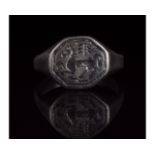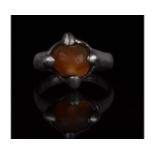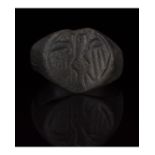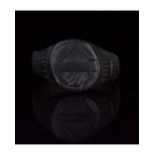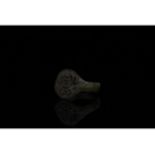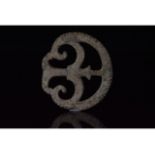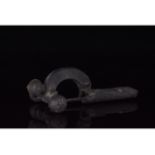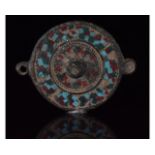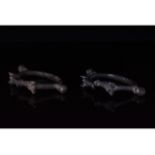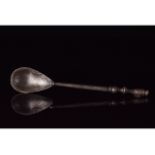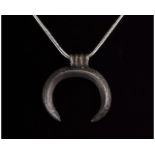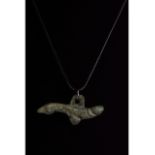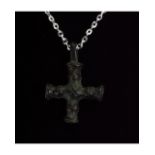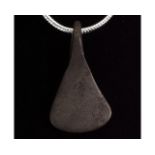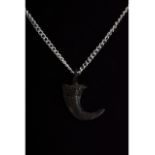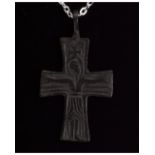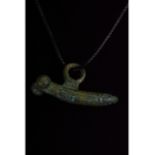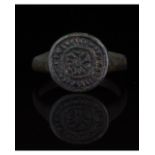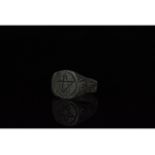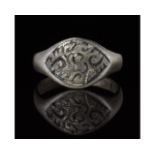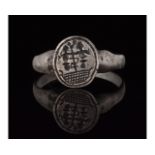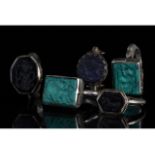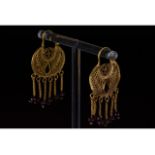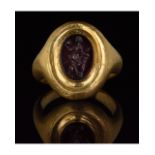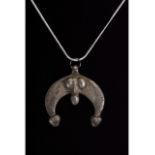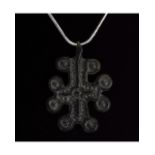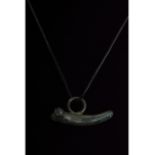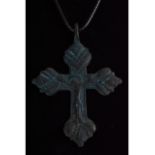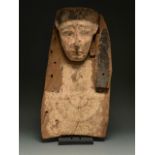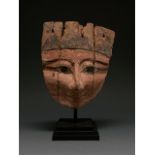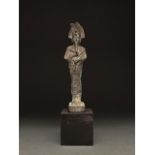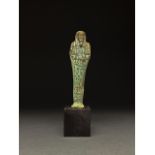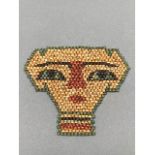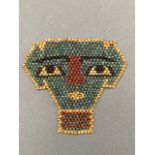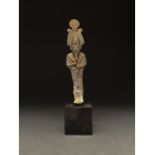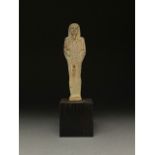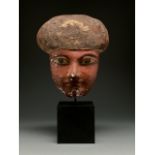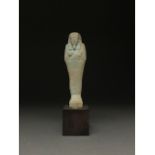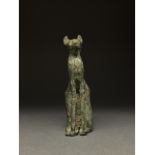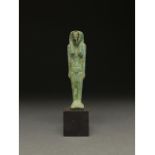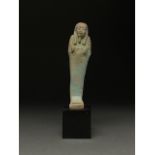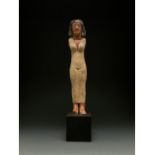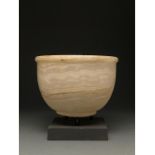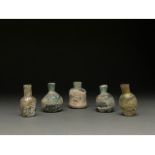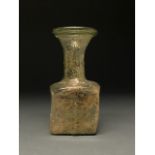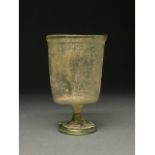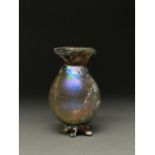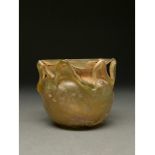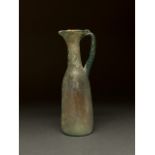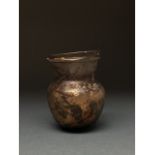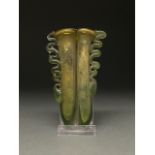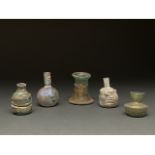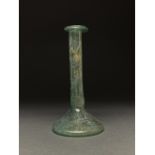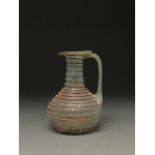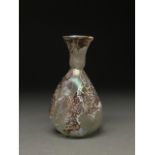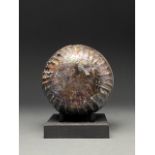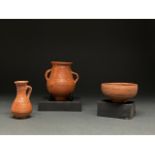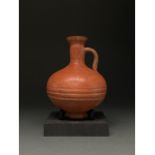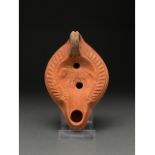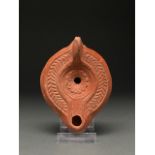Refine your search
Estimate
Category
- Arms, Armour & Militaria (123)
- Jewellery (85)
- Greek, Roman, Egyptian & Other Antiquities (43)
- Sculpture (26)
- Collectables (21)
- Glassware (16)
- Ceramics (5)
- Coins (5)
- Metalware (5)
- Chinese Works of Art (4)
- Vintage Fashion (4)
- Textiles (3)
- Wines & Spirits (3)
- Islamic Works of Art (2)
- Musical Instruments & Memorabilia (2)
- Salvage & Architectural Antiques (2)
- Taxidermy & Natural History (2)
- Tools (2)
- Lighting (1)
- Models, Toys, Dolls & Games (1)
- Scientific Instruments (1)
Filtered by:
- Show only bulk lots
- List
- Grid
A subscription to the Price Guide is required to view results for auctions ten days or older. Click here for more information
1-200 AD. Roman. Silver ring with D-shaped hoop and flattened, hexagonal bezel bearing an incised galloping horse motif. The cavalry played a majo...
700-1100 AD, Viking Age. Siver ring with a circular hoop, and a lozenge shaped bezel onto which is mounted a large, elliptical Carnelian gem. This...
1-200 AD. Roman. Heavy bronze ring with D-shaped hoop and flattened, rounded bezel featuring an incised eagle motif. An aquila (eagle) was a promi...
1100-1500 AD. Medieval/Crusader Period. Bronze ring with D-shaped hoop, with incised decoration on the shoulder and flattened, circular bezel feat...
700-1100 AD, Viking Age. A bronze ring with a heavy, D-shaped hoop with incised hatching decoration on the shoulders, and flattened, round bezel b...
C. 100-300 AD. Roman. Bronze scabbard fitting, perhaps part of a chape, which features abstract openwork decorative motifs. Chapes serve to reinfo...
300-400 AD. Late Roman. An excellent bronze crossbow brooch, with three onion-like protrusions, an arched bow, rectangular tail and surviving pin....
100-200 AD. Roman. A stunning enamelled disk fibula with a protruding central boss, two peripheral lugs and well-preserved repeating blue, red, an...
Ca. 300 BC. Celtic. Two heavy silver bracelets with boars’ head terminals. The boar was a symbol of hunting prowess in Celtic Europe, perhaps sugg...
c. 400 AD. Late Roman. Silver ligula, or spoon, with a squashed, teardrop-shaped bowl suspended from a square shank, which is in turn connected to...
Ca. 100 AD, Roman. Silver lunar amulet comprising a crescent moon with a wide banded suspension loop. In Roman mythology, Luna (the Moon) is somet...
ROMAN BRONZE PHALLIC AMULET
c. 1-200 AD. Roman. A bronze comprising a suspension loop connecting to a shaft with a glans delineated by incised decoration at one end, testes s...
VIKING AGE BRONZE CROSS PENDANT
C. 700-1100 AD, Late Viking Age. Bronze cross with four tupular armsa and flat terminals. The centremost section of the cross as an incised X, whi...
VIKING SILVER AXE SHAPED AMULET
700-1100 AD, Viking Age. A superb silver example of an axe or Perun amulet comprising a suspension loop and a stylised axe head. This type of amul...
700-1100 AD, Viking Age. Bronze pendant in the shape of a curved drinking horn, with integral suspension loop at the top and carefully incised dec...
1000-1500 AD, Medieval Crusader period. Bronze crucifix pendant comprising four flat arms, with squared off terminals bearing a stylised image of ...
c. 1-300 AD. Roman. A large bronze pendant comprising a phallus with the glans offset with incised decoration, two applied testes and an integrate...
1-300 AD, Roman. Ring with circular loop, and raised round bezel bearing an incised decoration comprising a sun motif surrounded by concentric cir...
1-200 AD. Roman. Heavy bronze ring with D-shaped hoop with incised decoration on the exterior, and flattened, rounded bezel bearing a pentagram wi...
700-1100 AD, Viking Age. A silver ring with a D-shaped hoop, an elliptical bezel with incised linear and curvilinear decorations, possibly runic s...
c. 1000-1500 AD. Medieval Crusader period. A silver ring with a round hoop and a circular bezel bearing incised decoration in the form of a ship a...
Ca.1700-1950 AD. Yemeni Tribal. Lot of five white metal Yemeni Tribal intaglio rings with turquoise and blue coloured intaglio stone settings some...
900-1000 AD, Byzantine. A pair of gold earrings in a lunate shape, decorated with extensive open-work floral motifs. At the top each earring is a ...
1-200 AD. Roman. Gold ring with D-shaped hoop, stepped, elliptical bezel and carnelian intaglio depicting a standing Diana, holding one of her att...
Ca. 100 AD, Roman. Silver lunar amulet comprising a crescent moon with a suspension loop, conical terminals, and an applied phallic pendant compri...
1000-1500 AD, Medieval Crusader period. Bronze cross pendant comprising four arms, the uppermost of which is curved to form a loop. The two arms a...
c. 1-300 AD. Roman. A large bronze pendant comprising a phallus with the glans offset with incised decoration, two applied testes and an integrate...
1000-1500 AD, Medieval Crusader period. Bronze crucifix pendant comprising four arms, with rounded terminals and incised linear decorations. In ad...
664 – 343 B.C. Late Dynastic / Ptolemaic Egyptian. A beautiful wooden sarcophagus lid with an intact mummy mask depicting an individual with a lig...
EGYPTIAN MUMMY WOODEN MASK
664 – 343 B.C. Late Dynastic / Ptolemaic Egyptian. A beautiful wooden mummy mask depicting an individual with a light reddish-brown skin tone, a r...
C. Ca.1070-945 BC Egyptian. Egyptian bronze figure of God Osiris, The god is shown mummiform with a braided divine beard curved out at its tip, an...
C. Ca.1070-945 BC Egyptian. Beautiful blueish-green faience ushabti figure wearing a tripartite wig, a striated false beard and holding a two hoes...
EGYPTIAN BEADED MUMMY MASK
664 – 343 B.C. Late Dynastic / Ptolemaic Egyptian. Beaded mummy mask made of delicate faience beads in turquoise, red, cream and black. The face i...
EGYPTIAN BEADED MUMMY MASK
664 – 343 B.C. Late Dynastic / Ptolemaic Egyptian. Beaded mummy mask made of delicate faience beads in turquoise, red, cream and black. The face i...
C. Ca.1070-945 BC Egyptian. Egyptian bronze figure of God Osiris, The god is shown mummiform with a braided divine beard curved out at its tip, an...
EGYPTIAN FAIENCE USHABTI
C. Ca.1070-945 BC Egyptian. Beautiful light green faience ushabti figure wearing a tripartite wig, a false beard and holding a two elongated objec...
EGYPTIAN MUMMY MASK
664 – 343 B.C. Late Dynastic / Ptolemaic Egyptian. A beautiful wooden mummy mask depicting an individual with a reddish-brown skin tone, a rounded...
EGYPTIAN FAIENCE USHABTI
Ca.1070-945 BC Egyptian. Beautiful light blue faience ushabti figure wearing a tripartite wig, a false beard and holding a two elongated objects. ...
EGYPTIAN BRONZE BAST FIGURINE
712-30 BC, Late Period/Ptolemaic. A bronze figurine showing the goddess Bast in cat form seated with alert, forward facing ears. The goddess Baste...
EGYPTIAN FAIENCE FIGURE
Ca.1070-945 BC Egyptian. Beautiful blue green faience female ushabti figure wearing a tripartite wig. Shabtis, also known as ushabtis, are Egyptia...
EGYPTIAN FAIENCE USHABTI
Ca.1070-945 BC Egyptian. Beautiful light blue faience ushabti figure wearing a tripartite wig, a false beard and holding a sheaf of wheat and a ho...
664 – 343 B.C. Late Dynastic / Ptolemaic EgyptianEgyptian. Wooden votive figurine of a woman with a bi-partite naturalistic black wig, arching eye...
EGYPTIAN STEATITE BOWL
ca. 2000 BC; Egyptian. A large crème coloured steatite bowl comprising a deep squat body, a flat circular base and a thick out-turned rim. This bo...
1-400 AD. Roman and Late Roman. A lot of five blown glass vessels, comprising (L-R): a yellow square sided bottle with a cylindrical neck; a turqu...
C 400. AD Roman. A beautiful light green mold blown bottle comprising a square body with a cross motif on one face, a long tubular neck, and a thi...
LATE ROMAN GLASS CHALICE
C 400. AD Roman. A beautiful light green glass chalice comprising a slightly flaring cylindrical body, a short sturdy stem, and a round concave fo...
LATE ROMAN GLASS FLASK
C. 400 AD Roman. A beautiful light green flask comprising a slightly globular body, a short flaring neck, and a wide flaring, inward folded rim, a...
LATE ROMAN GLASS JAR
c.400 AD. Late Roman. A beautiful light yellow jar comprising a rounded globular body, a short straight neck, and a wide flaring, outward flexed r...
LATE ROMAN GLASS JUG
c. 400. Late Roman. A beautiful light blue jug comprising a slightly tapering body, a long straight neck, a wide flaring, outward flexed rim, and ...
LATE ROMAN GLASS JAR
Ca. 1-300 AD Roman. A beautiful brown jar comprising a globular body, a short flaring neck with double outurned rims, and concave base. Glass was ...
Ca. 1-300 AD Roman. Ombre green glass double balsamarium with two conjoined phials. Each phial id decorated with applied ribbon handles draped in ...
Ca. 1-400 AD. Roman and Late Roman. A lot of five blown glass vessels, comprising (L-R): A squat jar with a flaring neck and mouth; a spherical bo...
ROMAN CANDLESTICK UGENTARIUM
Ca. 1-300 AD Roman. A Roman candlestick unguentarium in a green glass, featuring a short globular body with a concave base, a long cylindrical nec...
ROMAN GLASS JUG
Ca. 1-300 AD Roman. A beautiful light green jug with a long straight neck, flat, discoid outward flexed rim, a flaring globular body decorated wit...
ROMAN GLASS FLASK
Ca. 1-300 AD Roman. A beautiful light green flask with a long, outward flaring neck, rounded rim, and a flaring globular body punctuated with inde...
ROMAN PILLAR MOLDED BOWL
Ca. 1-300 AD Roman. A beautiful pillar moulded bowl with a rounded, slightly outward flexed rim, and characteristic ribs decorating the body of th...
C. 300-400 AD Roman. A lot of three terra sigillata vessels, including one globular jug with an outward flaring rim, applied flat handle and incis...
ROMAN TERRA SIGILLATA JUG
C. 300-400 AD Roman. A beautiful globular terra sigillata jug with an long thing nick, a slightly outward flaring rim, and applied flat handle and...
ROMAN TERRA SIGILLATA LAMP
Ca. 1-300 AD. Roman. A beautiful terra sigillata lamp depicting a wolf enclosed by a wreath of incised grooves. The oldest Roman lamps date to the...
ROMAN TERRA SIGILLATA LAMP
Ca. 1-300 AD. Roman. A beautiful terra sigillata lamp depicting a flower enclosed by a wreath of laurel leaves. The oldest Roman lamps date to the...

